| | Triticale grazing productivity and quality | Triticale use for green-feed and hay | Triticale use for swath grazing
Triticale Grazing Productivity and Quality
Some quick facts about triticale grazing productivity and quality:
- Spring-planted winter cereals alone or in mixtures with barley or oats (inter-cropping) provide an excellent source of pasture from mid-June until late in the fall (see Winter Cereals for Pasture, Agdex 133/20-1).
- Triticale grown for forage in cereal mixtures tends to offer the most positive traits related to survival and re-growth in a mixture, but will not always be the highest yielding annual forage solution.
- “Inter-cropping is the best alternative where annual forage is needed for fall season pasture, and extended ground cover is required to combat soil erosion for a longer portion of the year.” (Baron et al, 1993).
Triticale, either in spring or winter form, offers an excellent potential for extending the spring and fall grazing seasons.
The use of winter cereals such as winter triticale can provide farmers with a valuable alternative to perennial forages and can be used to extend the traditional grazing season into the early spring and late fall.
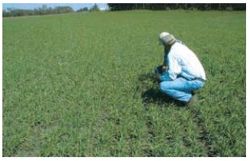
Photo - Recommended stage for starting grazing 6-leaf to tillering
Fall-seeded winter triticale
Fall rye, winter wheat, and winter triticale can provide some fall grazing and provide earlier spring grazing the next spring (early to late May) compared to perennials.
If the winter crop is intended for seed or silage production, grazing should be discontinued once crop elongation begins.
In general, the order of regrowth of green material in the spring follows (first to last):
- Fall rye
- Winter triticale
- Winter wheat
In Florida, Bertrand and Dunavin (1974) showed that triticale alone, or in mixture with ryegrass and crimson clover, were equal to rye as grazing forage for growing beef calves.
In studies with winter triticale in Missouri, Miller et al (1993) studied the effects of simulated grazing (clipping) on subsequent grain yield when used in a double-crop situation, and compared these to when winter wheat was used alone.
In this comparison, winter triticale performed as well as the winter wheat. However, it was also apparent that:
- To keep grain yield potential, grazing should not be allowed beyond the first node stage.
- If the main goal is yield, then the amount of grazing would have to be adjusted to allow the grain to recover sufficiently during the post-grazing portion of the growing season.
Spring-seeded winter triticale
When seeded in the spring, winter cereals (such as winter triticale) remain vegetative throughout the spring, summer and fall. There is no heading because seedlings do not receive the cold treatment, or vernalization, that would normally occur in the fall. Vernalization is required in order for heads to form the following summer. (Vernalization is a physiological change in the seedling, usually received in the fall when seedling temperatures that are below 5-7°C and low light intensity serve as triggers for the plants to develop heads the following year.)
Two options are commonly considered:
- Growing a mono-crop of winter cereal for grazing.
- Using a mixture of winter cereal and spring oat or barley.
The second option has a rapidly growing spring cereal, which allows for high grazing yield in the spring and early summer. It also allows the opportunity of using the blend for silage and subsequent grazing in the fall.
Seeding rates may be influenced by the intended end use. For example, if a blend or mixture of spring and winter cereals is intended for silage production and then fall grazing, seeding rates of 75% of the normal rates for each component in the mixture may be recommended. (Refer to the production section of this manual)
Mixing spring-planted winter triticale with tall varieties of oats or barley has been shown to be an effective source for spring and summer grazing as well as for silage. The barley and oat:
- Are very vigorous in the early growth stages.
- Dominate the canopy in the early stages of growth.
- Provide excellent forage quality.
After the earlier season grazing or silage harvest, the winter triticale becomes more dominant in the mixture. It has the potential to provide vigorous re-growth and high quality forage in late summer and fall. This is at the same time as the re-growth potential for spring cereals and perennials decreases.
Aasen (2004) reported that adding a one-half bushel of oats or barley to a winter cereal for spring seeding increased spring growth in a mixture, and also made the graze available 10 days earlier than either component by itself. When managed in this manner, spring and fall grazing potential improves as compared to other grazing options.
These effects are well illustrated by the results of a study at Lacombe from spring seeding a blend of winter and spring cereals. Researchers found that the spring forage yield came mainly from the spring cereal, and was taken over by the re-growth of the winter component later in the season (Figure 15).
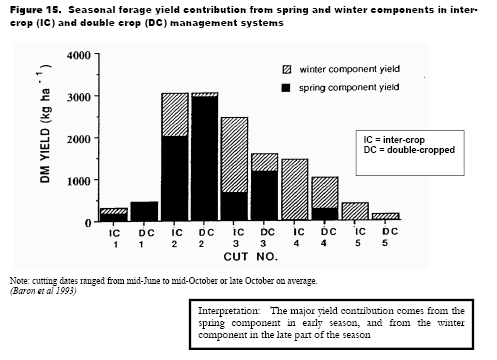 1 1
General grazing recommendations
The following should be done to avoid problems when grazing cereals, especially when the growth is very lush:
- Avoid acidosis by providing a straw supply or access to grass stands in adjacent pastures to supplement the low fibre content in the graze.
- Avoid high applications of nitrogen sources as high nitrate levels can cause problems on spring cereals. Frosts and drought usually increase nitrate levels. Know the lab quality of the forage feed being used. Sample and submit for feed analysis.
- Use mineral supplementation to avoid potential for grass tetany.
- Supplement grazing livestock with straw or hay to add fibre, reducing runny manure problems.
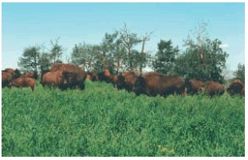
Photo - Bison grazing winter triticale
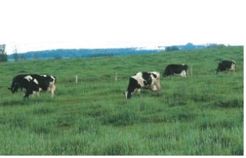
Photo - Dairy cows grazing winter triticale
Stocking rates
Suitable stocking rates can only be determined from experience, and depend on the circumstances of each graze crop. Saskatchewan Agriculture (Figure 16) recommends maximum stocking rates per acre of 1.1 to 2.5 for 1300 lb cows, and 2.1 to 3.6 for 700 lb steers on annual pasture, depending on the soil type and its productivity. Table 22 is an example of simulated stocking rates based on research conducted in Alberta. Palatability is not often a problem, and is better for winter triticale and winter wheat than for fall rye.
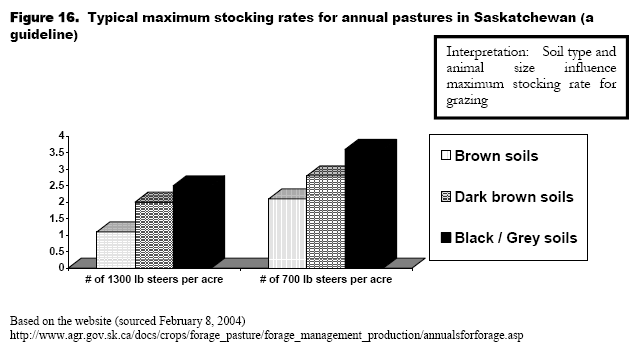
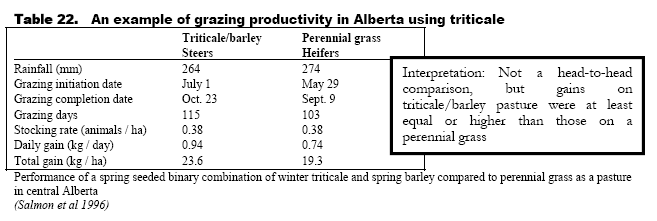
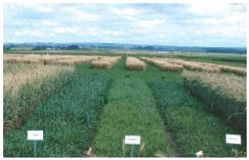
Photo - Grazing re-growth in plots at Lacombe. Pika (left plot) > Bobcat (right plot) > AC Rifle (center).
Triticale Use for Green-feed and Hay
There is little research on triticale being used for green-feed hay. However, the optimum time for harvesting cereals as dry hay is the same as silage stages of cutting, late milk to soft dough stages.
Triticale green-feed and hay can be managed similarly to other green- feed and hay sources. Dried-out, late harvested samples can cause palatability issues for animals and create mouth ulceration. These problems can be limited by using the semi-awnless winter variety Bobcat. Varieties with rough awns should be avoided for green-feed or hay or cut earlier before awns become hard and thick.
Triticale straw can be used in animal systems but, along with wheat straw, in not considered to have as high a feeding quality as barley or oat straw. This is likely because of the higher fibre content and lower energy content and protein.
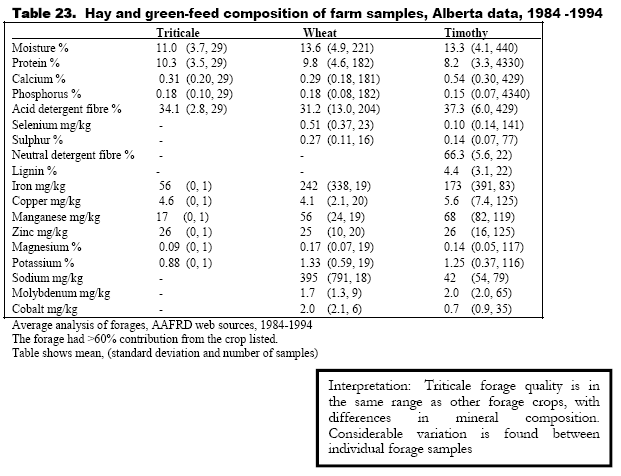
Triticale Use for Swath Grazing
Swath grazing is the swathing of late seeded cereals in mid-September at the soft dough to dough stage. The swath is left in the field for cattle grazing through the winter. The swathing is done late in the season in order to maximize quality for cattle grazing through the winter. Cattle can usually eat the swath even if the swath is under snow.
Swath grazing:
- Eliminates the cost and time of baling or silaging.
- Eliminates the cost of cleaning corrals and hauling manure from feedlots.
- Extends the field grazing season.
Successful swath grazers spend a lot of time managing their animals to ensure efficient grazing as well as good animal condition and health. Most users are grazing dry, mature, beef cows in reasonable body condition.
Most information about swath grazing is from producer experience and surveys. Best management practices for swath grazing are summarized below. Productivity data specifically describing swath grazing of triticale were not found in the literature.
Managing the crop
- Stagger seeding dates in different fields, so swathed crops are all at the soft to mid-dough stage at the desired swathing date. Late May to June seeded winter triticale works well in this application.
- Use winter triticale plus oat or barley as a mixture to improve the swath forage quality; raise seeding rates up to 25 percent more than for a grain crop.
- Use normal fertilizer rates. If soil N load is very high, and the crop is subjected to major stress during growth (frost, drought, cool weather), be aware of problems that sometimes develop from having high nitrate levels in the forage. If in doubt, send samples to a feed test laboratory.
- Delayed seeding for swath grazing allows for pre-seeding herbicide use. Check herbicides for restrictions on subsequent feed use.
- A crop previously planned for grain can be cut for swath grazing after a heavy frost.
- During the grazing period, animal manure can return high amounts of nutrients to the grazed field. Soil testing is recommended to determine fertilizer requirements for subsequent crops.
- Ensure that any swath residuals are fully grazed off, baled off, or spread in the field. This avoids residual damage to subsequently seeded crops from the swath strips.
Managing the animals
- Test swath quality before feeding to determine necessary levels of supplemental feed, and to estimate the likely duration of the graze period using the swaths in the field. Typical analyses should include fibre content, projected energy levels, protein level, calcium, phosphorus and nitrates.
- If swath grazing calves, young cows, thin cows or cows with calves, supplemental feed and minerals may be necessary, especially during periods of cold and snow.
- Choose fields for swath grazing that are sheltered from the wind, and close to buildings and a water source.
- Choose fields where wildlife grazing will be minimized, as wildlife will trample swaths and reduce the amount of available feed.
- Monitor swath use and ease of access. Blade away snow drifts if the drifts deeply bury the swaths or if snow becomes hard-packed.
- Animals can efficiently graze snow-covered swaths late into the winter with proper management (for example, the use of electric fencing).
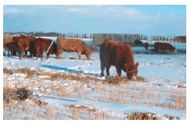
Photo - Swath grazing for beef cattle |
|